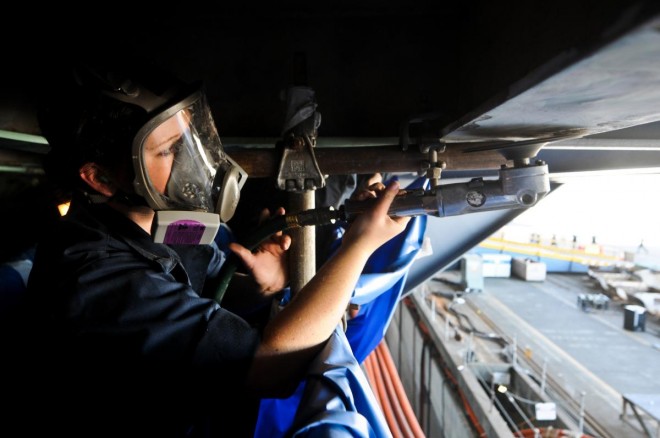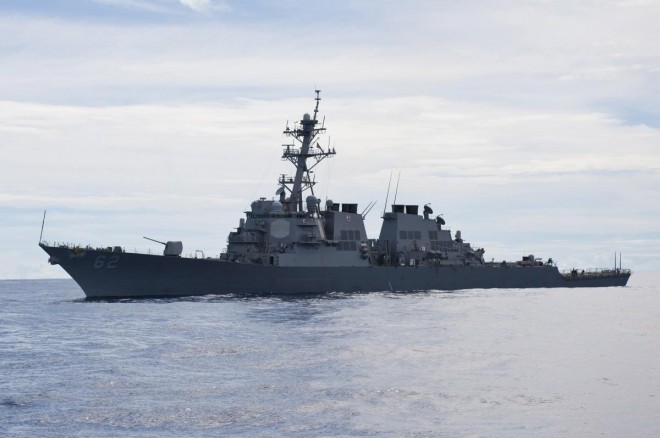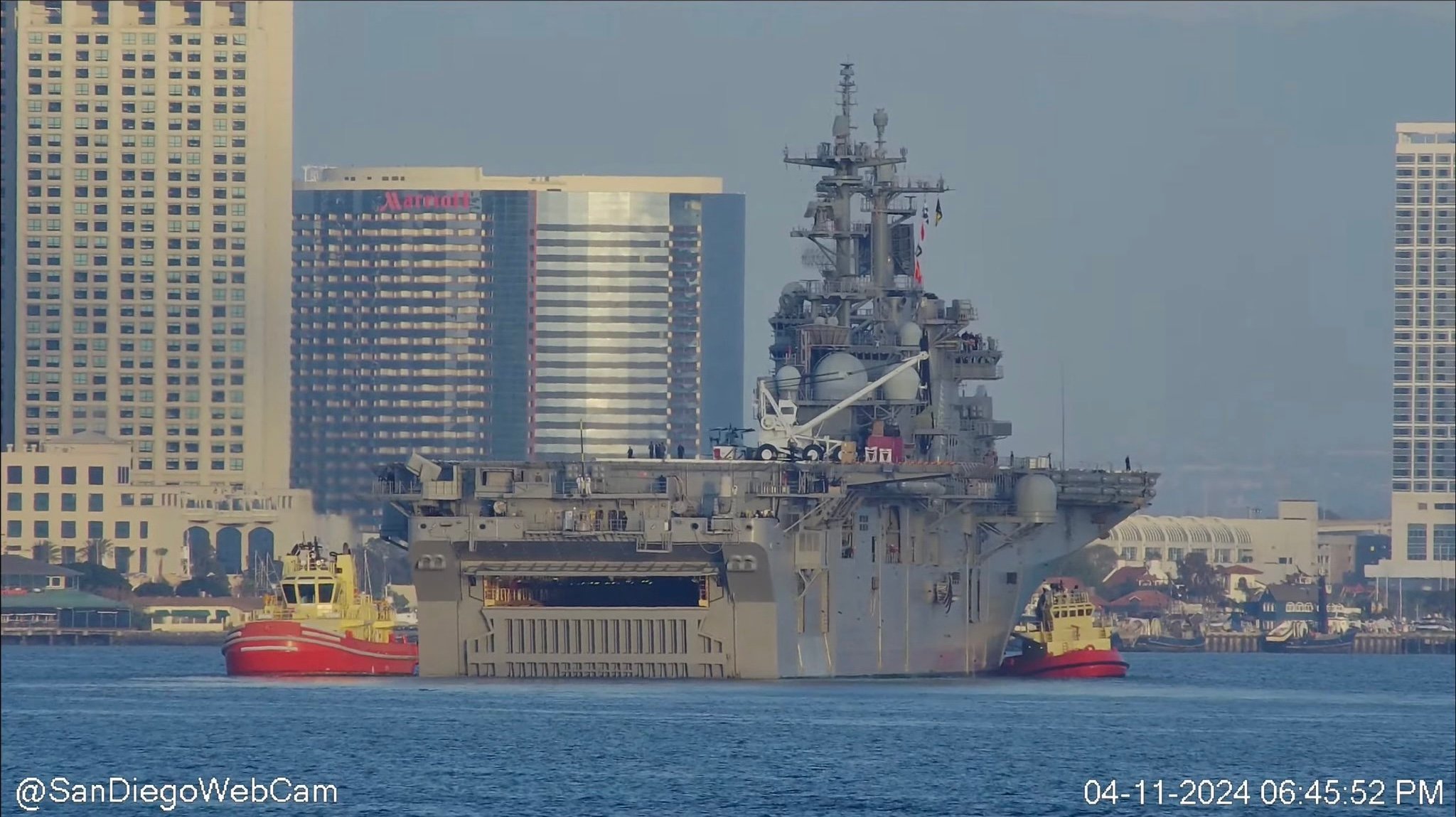More than a decade ago, Navy leaders decided to abandon historic standards for ship-manning levels and for shipboard maintenance, supposedly to make the Navy more “business-like” and “efficient” and to make more money available to buy a new generation of ships and weapons.
But the result instead was a sharp drop in the material readiness of the surface ships and a continued decline in fleet size, which forced the leadership to work the remaining operational ships and their smaller crews harder, thus aggravating the problems.
With congressional committees, Navy inspectors and a high-level outside panel issuing increasingly shrill alarms, the leadership finally is acting to correct those mistakes.

This week, as he prepares to retire and turn over Fleet Forces Command on Friday, Adm. John C. Harvey has fired off a lengthy message to the surface warfare community and its supporting organizations warning that “the cumulative impact of individual decisions made over long periods of time had put the future readiness of our surface force at risk.”
And he charged those who will remain on watch to adhere to the old proven standards and procedures to restore the surface fleet to its historic state of combat readiness.
It was a strong message from Harvey, who had remained surprisingly quiet about the growing readiness crisis earlier in his tour at FFC.
In his parting proclamation as the “Old Salt” — the longest serving surface warfare officer Harvey acknowledged that there was “much more” he could have done “to fully evaluate the impact the actions I’ve described to you had on our surface force’s overall mission effectiveness.”
He attributed his failure to having “focused too exclusively on the tasks and responsibilities immediately at hand” rather than considering the broader impact of the mistaken policies.
But he also spread the blame to his fellow “community leaders” for failing to “get to the heart of the matter: our sailors and our ships and their collective readiness to carry out our assigned Title 10 missions.”
“I could have done better. We could have done better. You MUST do better, because now we know better,” Harvey declared.
Harvey blamed the surface fleet’s plunging readiness status on the decisions made around the beginning of this century to replace the traditional rules for crew size and routine shipboard maintenance with “optimal manning” and “just-in-time maintenance.”
Although Harvey did not attribute those actions to any one person, a leading advocate of those changes had been Adm. Vern Clark, the chief of naval operations from July 2000 to July 2005. Clark, who had an MBA, argued that the old rules had been rendered outdated by technology and proven business practices.
He promised that the money saved by those “efficiencies,” along with decisions to retire dozens of ships with years of service life remaining rather than pay for updates, would buy enough new ships to build the fleet up to the goal of 330 ships.
The fleet now has 286 ships.
“We certainly developed a large number of plans to achieve greater efficiencies, but we did not pay sufficient attention to rigorously evaluating the products of those plans, particularly as their effects on our surface force grew over time,” Harvey said in his email message.
“We reduced manpower requirements on our ships based on technology initiatives that did not deliver as expected and then manned our ships to 90 percent of that lower requirement We shifted maintenance ashore, scaled back our shipboard 3M program and reduced our preventive maintenance requirements to fit a smaller workforce, and then failed to fully fund the shore maintenance capacity we required,” he said.
“The result was optimally-manned ships that we could not maintain to the performance and reliability standards we previously mandated in order to achieve mission success over service life.”
In the fleet, “optimal manning” became better known as “minimal manning,” as it resulted in not just smaller crews but also fewer senior and better trained petty officers, who were no longer needed to supervise the traditional inspections and maintenance on board.

“In the process, we trained our people on the deckplates that improving efficiency trumped all other considerations — certainly an approach and a philosophy that was completely contrary to the institutional culture of ownership this is MY ship; this is MY gear — and the institutional focus on operational readiness we are ready NOW that have been at the very foundation of our surface force since its beginnings,” Harvey wrote.
That led to “too many sailors who no longer understood what right looks like,” and standards that “dropped with every cost-cutting measure we implemented. An example of this phenomenon is when we see a very big delta between a ship’s actual day-to-day standards and what is required to perform satisfactorily on INSURV, which should be a come as you are inspection that we routinely pass,” he said, referring the Board of Inspections and Survey.
The cumulative impact of the new policies began to explode outside the surface warfare community, showing up in disturbing reports of ships being declared unable to deploy because they failed their INSURV inspection, or ships already on deployment being forced into port by failures of critical equipment or hull structures.
One of the most alarming disclosures was recurrent problems with the radars and combat systems in the Aegis-equipped cruisers and destroyers, which are vital to the protection of the deployed aircraft carriers and increasingly key part of ballistic missile defense.
Those problems drew the attention of Congress, particularly the House Armed Services Seapower and Readiness subcommittees, which held a number of hearings and issued reports blasting the Navy leaders.
In one notable session on July 12, 2011, the Readiness panel heard Vice Adm. William Burke, the deputy CNO for Fleet Readiness, and Vice Adm. Kevin McCoy, commander of Naval Sea Systems Command, concede that fleet readiness had dropped sharply, with one fourth of the ships failing their INSURV inspections.
“We’re not good to go today,” McCoy said. “In the near term I suspect that some of these indicators will actually turn a little bit harsher.”
The Navy leadership already knew those grim facts, because Harvey and Adm. Robert Willard, then Commander Pacific Fleet, had ordered a high-level review of surface fleet readiness, led by retired Vice Adm. Philip Balisle, a former NAVSEA commander.
The seven-member Balisle panel had concluded, “Surface Force readiness has degraded over the last ten years. This degradation has not been due to a single decision or policy change, but was the result of many independent actions.”
Among the damaging changes, the board cited “dramatic cuts” in the manning of the Shore Intermediate Maintenance Activities and the Regional Maintenance Centers, “the historic source of support for shipboard maintenance;” the optimally manned changes that” caused a diminution of on-board” knowledge, experience and oversight, and reductions in training for sailors and surface warfare officers.
The panel also noted “the lines of authority, responsibility and accountability have become unintentionally blurred in the surface force and have hindered surface force effectiveness.”
“The downward spiral of the culture is seen throughout the ship through long-standing acceptance of poor housekeeping, preservation and corrosion control. Over time, the ignored standard becomes the new norm. While the severity of the current culture climate can be debated, its decline cannot,” the panel said.
It also found that surface ship maintenance “has been significantly underfunded for over ten years,” which is reflected in “the degraded material condition of the ships” as shown in the INSURV reports, corrosion audits and reports of equipment failure.
The Balisle panel also reported that the vital Aegis combat systems and radars on four of eight cruisers inspected were found to be in “degraded” or “unsatisfactory” condition.
Harvey noted that the Navy has been taking corrective action.
“So, having recognized what happened and what we needed to do to get back on track, we’ve been at it — hard. Over the past several years, in very close partnership with the Surface Navy’s greatest friends — Vice Adm. Kevin McCoy and his NAVSEA team — we’ve cleared out a lot of the underbrush. I strongly believe that we must now keep the press on with our efforts, but with a far sharper focus on assigning the correct responsibilities to the accountable officer(s) in the appropriate organizations and ensuring we are getting the full value of every readiness and maintenance dollar we spend.”
He stressed that the emphasis had to be on effectiveness and not on saving money.
“If it’s cheap, efficient, but doesn’t work, it does us no good.”
“I’ve had my say and my turn at the wheel; now it is your turn — your time to break the Battle Ensign and lead our community into the future.”
“Never, never, never give way on the standards of excellence that have made us the greatest Navy in the world, bar none. And never forget that the fundamentals of surface warfare are our ships and Sailors,” the Old Salt concluded.




